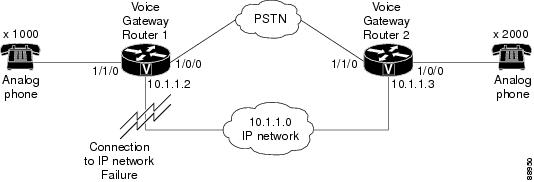Two Analog Phones
The simplest and most ubiquitous implementation of dial peer configuration involves connecting two standard analog telephones over an IP network. The following two examples illustrate the minimum required configurations necessary to connect two analog phones, where they are attached to the same voice gateway router and where each phone is attached to its own voice gateway router via FXS ports installed in the voice gateway routers in question.
Both Connected to the Same Voice Gateway Router

Voice Gateway Router Configuration File
voice-port 1/0/0
!
voice-port 1/0/1
!
!
dial-peer voice 1 pots
destination-pattern 5551234
port 1/0/0
!
dial-peer voice 2 pots
destination-pattern 5555678
port 1/0/1Each Connected to Their Own Voice Gateway Routers Using the G.711 Codec

Voice Gateway Router 1 Configuration File
voice-port 1/0/0
!
dial-peer voice 1 pots
destination-pattern 5551234
port 1/0/0
!
dial-peer voice 10 voip
destination-pattern 5555678
session target ipv4:10.5.6.7
codec g711ulawVoice Gateway Router 2 Configuration File
voice-port 1/0/0
!
dial-peer voice 2 pots
destination-pattern 5555678
port 1/0/0
!
dial-peer voice 20 voip
destination-pattern 5551234
session target ipv4:10.2.3.4
codec g711ulawEach Connected to Their Own Voice Gateway Routers Using the G.729r8 Codec
Voice Gateway Router 1 Configuration File
voice class codec 1
codec preference 1 g729r8
codec preference 2 g711ulaw
!
voice-port 1/0/0
!
voice-port 1/0/1
!
!
dial-peer voice 1 pots
destination-pattern 5551234
port 1/0/0
!
dial-peer voice 2 voip
destination-pattern 5555678
voice-class codec 1
session target ipv4:10.5.6.7Voice Gateway Router 2 Configuration File
voice class codec 1
codec preference 1 g729r8
codec preference 2 g711ulaw
!
voice-port 1/0/0
!
voice-port 1/0/1
!
!
dial-peer voice 1 pots
destination-pattern 5555678
port 1/0/0
!
dial-peer voice 2 voip
destination-pattern 5551234
voice-class codec 1
session target ipv4:10.2.3.4




 Feedback
Feedback